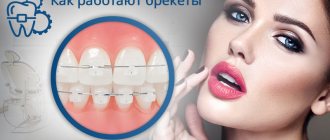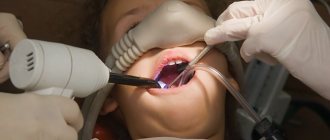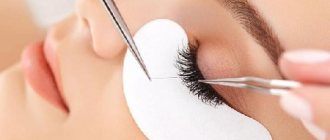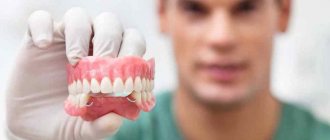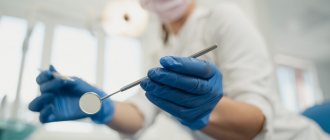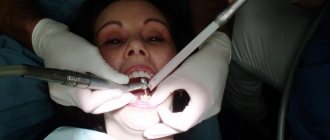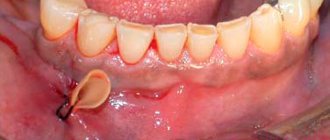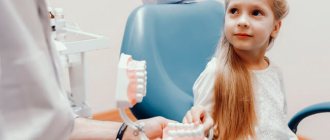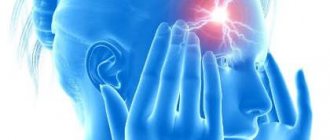Children's dental prosthetics is an opportunity to quickly restore a damaged, lost or missing primary or permanent bite unit. The dental procedure takes 20-40 minutes and is suitable for children of almost any age.
Any tooth loss before the child reaches 6 years of age is considered abnormal and requires urgent solution to the problem.
The lack of timely prosthetics leads to problems with chewing and speech, and provokes the development of bite pathologies.
Why do you need dentures for baby teeth?
Prosthetics of primary teeth involves the restoration of damaged or extracted teeth in children using artificial materials. In this case, you can install either one denture or a bridge of several crowns. It used to be that only adults needed dentures. But relatively recently, doctors came to the conclusion that premature loss of baby teeth seriously impairs chewing function and negatively affects the child’s overall health. In addition, the absence of baby teeth significantly spoils the baby’s appearance and, as a result, undermines his self-confidence. Therefore, today parents, concerned about the mental and physical condition of their children, are increasingly turning to clinics for prosthetics of baby teeth, thereby ensuring the continuously growing popularity of this area in dentistry.
Indications for dental prosthetics in children
Only a pediatric dentist can give an accurate answer to the question of whether your child needs prosthetics for baby teeth. Typically, prosthetics of baby teeth in children is carried out if the following indications exist:
- Destruction of a baby tooth by caries and the impossibility of its restoration.
The absence of molars negatively affects the chewing of food, leads to stomach diseases and unwanted weight loss in children. The loss of frontal teeth can provoke the occurrence of speech defects or psychological complexes. - Tooth decay due to fluorosis.
This chronic disease develops even before teeth erupt, and subsequently causes stains on them and leads to their destruction. Dentures for baby teeth help prevent this process and preserve the aesthetics of a child’s smile. - The need for tooth extraction due to inflammation of the periosteum.
This disease often causes the appearance of neoplasms accompanied by pain. Often in such cases, the tooth must be removed. - Loosening or loss of teeth due to periodontitis.
This is a disease that affects the connective tissue between the bone of the tooth socket and the root cement. It can also lead to unwanted tooth loss in a child, and therefore is another indication for dentures for baby teeth. - Early loss of baby teeth.
Loss of a baby tooth a year or more before the appearance of a permanent one leads to shortening of the dentition in the permanent dentition in children, abnormal eruption of permanent teeth and significant disturbances in the dental system. - Tooth injury.
Children, due to their active lifestyle, are much more likely than adults to be injured. And the premature loss of even one baby tooth, as noted above, can lead to undesirable consequences for the child’s body. - Involuntary grinding of teeth (bruxism).
If not treated promptly, this disease can lead to deformation or premature loss of the tooth. - Edentia.
This is a complete or partial absence of teeth, which can be either congenital or caused by objective reasons.
Partial congenital or acquired adentia is a fairly common pathology of the dental system, both in adults and in children and adolescents.
The number of young people with lost permanent teeth is significant. According to some data, the frequency of dental defects due to premature removal of permanent teeth in people aged 13-15 years is 12.7%, and at the age of 15-19 years it reaches 25%.
The incidence of congenital adentia, excluding third molars, varies from 1.5% to 28.5%.
Against this background, the problem of the effectiveness of dental implantation is relevant.
Consequences of dental defects
It is known that the presence of even a single defect in the dentition is an etiological factor in deformations of the dentofacial complex and morphofunctional changes in the dentofacial system. First, these changes occur near the defect, and then spread to the entire dentition.
Among the pathological changes caused by adentia are the vertical movement and inclination of the teeth limiting the defect and antagonist teeth, their overload, corpus movement and occlusion disorders, the appearance of diastemas and three, which are most noticeable on the upper jaw.
Removal of the first permanent molars inevitably leads to shortening of the dentition, and in 39% of cases the midline shifts and vertical deformations are observed.
According to V.V. Gordova and a number of other researchers, early tooth loss negatively affects the tone of the masticatory muscles (decreased electrical potential, impaired contractility), complicating their further physiological development, contributing to changes in the articular disc of the TMJ.
In the absence of a tooth, the growth of the alveolar process slows down due to the cessation of mechanical stimulation and the weakening of the activity of reflex arcs coming from the periodontium of the teeth. The absence of a molar in the lower jaw negatively affects the stress-strain state of the jaw bone tissue and promotes resorptive processes in the area of the extracted tooth.
Premature loss of even one permanent tooth leads to disruption of the formation of a permanent bite, the correct growth of the jaw bones and facial skeleton, the formation of interocclusal relationships and bite height, the size and shape of the dental arches. In addition, there is a tendency towards distal displacement of the lower jaw, the occurrence of TMJ dysfunction and a decrease in chewing efficiency.
Often these disorders become irreversible, which is typical for people of any age, but most of all this applies to young patients. This is due, first of all, to the growth and development of organs and tissues, including the jaw bones.
If there is a defect in the dentition in childhood, the question of its restoration always arises. The problem of rehabilitation of children and adolescents with missing permanent teeth is widely discussed in the scientific literature, but studies indicate that prosthetic treatment in childhood is episodic.
Methods of dental prosthetics in children and adolescents
It is well known that dentures must maintain articulatory balance, not interfere with growth and stimulate the development of edentulous areas of the jaw. However, there is no consensus among researchers about treatment methods for children and adolescents with missing permanent teeth.
Bridges are practically unsuitable for replacing missing teeth in early ages, as they can retard the growth of the jaws. The use of sliding prostheses is labor-intensive; they are cantilever, non-physiological and ineffective.
Therefore, most often, dental defects are replaced with removable dentures, which are accessible and easy to manufacture. However, these structures are also unphysiological, and children are sensitive to the need to use removable structures and are often irresponsible in their approach to hygienic measures for the care of dentures, which negatively affects the ecosystem of the oral cavity.
Due to the widespread use of prosthetic techniques based on intraosseous dental implants in adults, scientific publications actively discuss the issues of such prosthetics in children and adolescents with dentition defects.
Research in this area began in the 80s of the last century.
The main problem that has worried and continues to worry researchers is the potential dependence of implants on conditions that change in the maxillofacial area during the process of growth and restructuring of the child’s body.
Features of dental implantation in childhood: a review of studies
Significant progress has been made and the effectiveness of the dental implantation method has been proven for the dental rehabilitation of children with ectodermal dysplasia.
Studies of the dependence of jaw growth on the presence of implants in children with hypohidrotic ectodermal dysplasia and congenital adentia have not found any disturbances in the growth of the jaw bones either in the sagittal or transversal directions.
Thus, in the works of Filius, Sharma, Kearns and other authors, 40 implants were installed in children aged 6-11 years with ectodermal dysplasia. Over the course of 6 years, in all clinical observations, dental implants installed in the frontal region of the lower and upper jaws did not limit their growth in the sagittal and transversal directions, and no violation of osseointegration was observed.
During clinical observations, one implant in the lower jaw and 4 in the upper jaw were partially immersed in the bone, which required orthopedic correction.
Research by O.B. Nenadova, who performed prosthetics on such children aged 3 to 18 years, confirmed their results. The survival rate of dental implants was 97.2%, and control examinations after 3, 6, 12, 18 months did not reveal any significant disturbances in the development of the jaws.
Some patients underwent correction of orthopedic structures.
As for children with normal jaw development and missing teeth, in 1989 the German Association of Implantologists recommended that they should not undergo implantation until they reach 13-15 years of age due to possible bone development disorders.
An exception, according to German experts, may be children with congenital diseases accompanied by multiple edentia.
Sharma and Vargervik do not recommend using this method of orthopedic rehabilitation before puberty due to disruption of the processes of growth and formation of the jaw complex, however, they note that not all patients experience such disturbances.
The authors emphasize that the use of dental implantation must be planned in close connection with the age, number and location of lost teeth, as well as the gender of the patients.
Researchers believe that the use of implants to replace dental defects in growing children allows them to maintain bone volume and has virtually no effect on jaw growth.
The alveolar process of the upper jaw and the alveolar part of the lower jaw grow synchronously with the development and eruption of teeth. The number and degree of formation of teeth determine the age-related sizes of the corresponding sections of the jaws.
The formation of the roots of permanent teeth ends in the following periods:
- incisors - at 10-11 years old;
- fangs - 14-15 years;
- premolars - 12 years;
- first molar - at 10 years;
- second molar - at 15 years.
The final closure of the periodontal fissure ends one year after the end of root formation. This shows that in most children under 12-14 years of age, the formation of the alveolar process of the upper and alveolar parts of the lower jaw ends.
Fundamental studies of the development of the craniofacial complex by Bjork and modern authors prove that after the eruption of all permanent teeth (with the exception of the third molars), the jaw bones stop growing in the sagittal and transversal directions.
From this moment on, only a slight growth of the alveolar process continues in the vertical direction, and therefore the use of dental implants in childhood and adolescence is recommended.
Brahmin, Rakhan and other authors believe that the use of implants during the growth period allows maintaining bone volume and has virtually no effect on the growth of the jaw bones, and those minor changes in the vertical direction are compensated by replacing the orthopedic structure.
Thilander's studies showed that during a 10-year follow-up of adolescent patients with single dental implants, infraocclusion was observed in 7 out of 17 patients, most often in the area of the lateral incisors.
Infraocclusion ranged from 0.13 to 0.98 mm, in the premolar area from 0.1 to 0.6 mm, in the canine area no infraocclusion was found in any of the described cases.
The results showed that dental implantation is indicated in adolescence to replace defects in the dentition and does not significantly affect the development of the dentofacial complex.
Ledermann believes that the bone segment with the implant does not lag behind in growth from the neighboring sections of the jaw bones.
Based on the results of prosthetics for children aged 9 to 14 years with the absence of permanent teeth using intraosseous implants A.V. Kuznetsov concluded that there were no disturbances in the development of the maxillofacial region of the patients.
Some researchers are inclined to think that the younger the child’s age, the greater the likelihood that the implant will influence the growth of the jaw bones.
However, there is no consensus in the literature about the age restrictions for implantation and its possible consequences on the development of the jaw bones.
D.S. Dmitrienko studied 1,744 children aged 9 to 17 years with single dental implants and found no significant differences in the size of the dental arches in the sagittal and transversal directions. However, in the vertical direction some changes were noted in the gnathic part.
In this regard, the author concludes that single dentition defects are indications for dental implantation in childhood and adolescence.
Dmitrienko recommends that the orthopedic part of rehabilitation during the period of incomplete growth of the craniofacial complex be carried out in two stages: first, make temporary structures, and upon completion of physiological gum retraction, replace them with permanent metal-ceramic structures.
The author notes the positive effect of intraosseous dental implants on slowing down the atrophy of bone tissue of the alveolar process.
Heuberer, Dvorak et al followed 18 edentulous children (mean age 12.5 ± 2.6 years) who had 71 dental implants for 11 years. During this time, no significant bone tissue damage was detected in the implantation areas.
The survival rate of dental implants was 89%; correction of the orthopedic structure was carried out in half of the examined patients, on average after 7.8 ± 4.5 years.
An interesting study is by Liu and Behrents, who published the results of experiments in beagle dogs on the relationship between implants and bone during growth.
3 months after implantation, an assessment of radiographs showed that all implants were well integrated with the bone, the implantation was local, and did not inhibit the growth and development of the jaw bone.
Another study on dental implants in children, conducted at the University of Colorado Health Sciences Center, found that after dental implants, jaw formation is disrupted in all directions during bone growth (ages 6-8).
These conflicting data showed that the implant is able to remain in the bone at the point of its formation and retards jawbone growth because it can neither move nor adapt to bone remodeling.
Increasing discrepancy between the implant and bone can lead to implant failure, so the authors do not recommend implantation during the active growth period. It should be started no earlier than puberty (12-14 years), since implantation during this period has more predictable results.
The authors recommend that implantation be carried out under strict clinical supervision.
If any signs of impaired jaw growth are detected, immediate removal of the implants should be insisted on.
Bergendal published a statistical analysis of implant use in children under 16 years of age in Sweden. The purpose of the study was to compare the effectiveness of the use of dental implants in children with congenital non-syndromic edentia, secondary edentia due to trauma and hypohidrotic ectodermal dysplasia.
Research results show that among 5 children with ectodermal dysplasia, who had 14 implants installed, 9 were lost due to unfavorable anatomical conditions, and not due to impaired osseointegration due to somatic pathology.
In the group of children 14-15 years old without somatic pathology (21 patients), only two had problems with osseointegration of dental implants. The authors note that implant treatment in growing children should be done with caution.
No less interesting is the study by Zachrisson, which examined the long-term results of aesthetic rehabilitation of patients with implants. The author studied infraocclusion of implants in the frontal region of both jaws in individuals of all ages.
When studying vertical changes in implant prosthetics in a group of young patients (from 15 to 21 years old) in the long-term period (about 4.2 years), there was a decrease in the occlusion of crowns on implants by an average of 0.7 mm (from 0.1 to 1.4 mm).
Similar results were obtained in studies in a group of mature patients (40-55 years old) - a decrease of 0.9 mm on average (from 0.1 to 1.8 mm).
These data indicate that changes in crown height and individual differences among patients were independent of age.
Dental implantation in the context of the development of the dentofacial system
When choosing a method for replacing teeth, the dentist must have a clear knowledge and understanding of the growth and development of the maxillofacial region in children and adolescents.
When planning and conducting dental rehabilitation, especially orthodontic and orthopedic, the doctor intervenes in the development processes of not only the dentition, but also the maxillofacial complex, and manipulation of this process should only be for the benefit of the patient.
This is especially true in childhood and adolescence, when it is important to be able to distinguish developmental anomalies within the physiological norm from a pathological process.
The choice of method of orthopedic treatment of dentition defects in childhood and adolescence is based on the principles of development of teeth and jaws, as well as on the mechanisms of craniofacial growth. The growth and development of the upper and lower jaws are very different.
This also applies to specific areas of each jaw.
The development of the maxilla in early life is closely related to the base of the skull, implying "growth from under the skull." Two processes are observed here: a significant displacement of the anterior and lower parts relative to the base of the skull and reconstruction of its anterior surface. Later, the size of the upper jaw only increases.
There are vertical, transverse and anteroposterior growth of the jaw.
Transverse growth occurs mainly in the area of the middle palatal suture.
The vertical growth of the upper jaw is due to its passive displacement. It is development in the vertical direction that influences the stability and effectiveness of dental implants at an early age.
The growth of the mandible mainly occurs downward and forward due to both intracranial growths during growth and apposition and resorption of bone on its surfaces.
The growth of the jaw is not only linear, it is combined with rotation and depends on the orientation of the sprout. As a site of growth, the anterior region of the jaw is practically inactive.
It is carried downwards and forwards, the main development of the mandible extending along the posterior surface of the ramus by the overlay of new bone.
In parallel with the growth of the lower jaw in length, it also increases in width due to expansion in the lateral regions.
Mandibular growth may also have some influence on the stabilization and displacement of dental implants, especially in the posterior regions due to vertical growth and resorption processes.
In adolescence, accelerated skeletal growth is observed in girls from 10 to 12 years old and boys from 12 to 14 years old. Peak growth begins approximately 2 years after puberty. The cumulative growth curve of the facial skeleton is parallel to the somatic growth curve.
Behrents' research has shown that facial growth continues beyond adolescence. However, it is correct to believe that growth processes slow down significantly after puberty. It is also important to assess growth rates in three dimensions.
Width growth is one of the first to stop, reaching its practical completion at the beginning of ripening. Significant anteroposterior growth of the maxillary skeleton lasts longer and ends at the end of puberty.
Vertical growth, which stops after puberty, is observed at a moderate level throughout adult life.
Therefore, despite studies conducted by domestic and foreign authors, there is no opinion on the use of dental implants in growing patients.
In the last decade, an increasing number of literature sources have suggested the possibility of implantation in adolescence.
However, there are no clear indications for the use of dental implants depending on the age of the child, the location of the defect, and its length.
The authors differ on the types of implants, suggesting that patients under 15 years of age can be either permanent or temporary, with subsequent replacement.
Particularly noteworthy is Sharma's conclusion about the possibility of installing a dental implant at an age when the formation of the root of the replaced tooth has been completed.
Features of dental prosthetics in children
Children's dental prosthetics has its own nuances. Firstly, in adults the jaw is formed, while the child is growing all the time, and the dentist must do everything possible to ensure that the prosthetics of baby teeth does not disrupt the development processes in the body. Therefore, dentures for children must be hypoallergenic, safe, comfortable, and resistant to chemicals. Therefore, for the manufacture of children's dentures, materials such as acrylic, chrome-plated steel, stainless steel, silver and tin alloys are used. Secondly, children's structures should not interfere with jaw development.
According to their purpose, dentures for children are divided into the following groups:
- therapeutic – restore functions and correct the structure of teeth;
- preventive – prevent deformations and pathologies in the development of teeth and jaws;
- fixing – used for fastening orthodontic appliances and therapeutic materials.
Interesting fact!
Hippocrates called children's teeth milk teeth. He was convinced that the first set of human teeth developed from the milk that infants fed.
Our advantages
The dental clinic on Polezhaevskaya “Personal Doctor” is conveniently located next to the Polezhaevskaya metro station; residents of nearby metropolitan areas can easily reach it. Separate rooms and a cozy interior will always delight little patients and allow treatment to be carried out in a comfortable, peaceful atmosphere.
You can make an appointment for children's prosthetics with our specialists by phone or online on the website. We offer interest-free installments for all types of services provided by our clinic. We use only high-quality consumables and reliable equipment.
Types of dentures for children
Typically, children are fitted with fixed, removable or conditionally removable dentures. Removable (temporary) dentures are made according to individual jaw impressions, sometimes with additional elements (screws, springs, arches). In children's dental prosthetics, they are installed when several teeth are missing to widen the jaw or correct the position of the teeth, and they must be regularly replaced as the child grows. Fixed dentures are installed for long-term wear and are removed along with the falling out milk teeth.
Why choose prosthetics at Aza&Buka dentistry
Dental prosthetics for children is a responsible dental procedure. The doctor must take into account many points - characteristics of the bite, growth rates, the presence or absence of certain diagnoses. The prosthetic structure should grow with the child, be comfortable to wear and not interfere with the harmonious development of the patient.
At Aza&Buka, special attention is paid to the safety and quality of dental procedures. Prosthetics in pediatric dentistry is:
- Fast and comfortable. The doctor will conduct a diagnosis immediately during the appointment and select the optimal prosthetic option.
- Complex work of specialists. If necessary, the child will be examined by an orthodontist, a dental therapist, or a dental surgeon. The best decision for the patient will be made.
- Painless at every stage. For especially young children or complex patients, prosthetics will be performed under general anesthesia or deep sedation.
- High quality result. A crown will completely replace a damaged or missing tooth - aesthetically, anatomically, functionally.
- Modern equipment, best brands. Young patients will be offered ready-made dentures or crowns made from acrylic, nylon, ceramics, metal, and zirconium dioxide.
At Aza&Buka dentistry, we provide prosthetics for permanent and baby teeth for patients of any age.
Dentures for teeth
| Type of prosthesis | Material | Characteristics |
| Crowns | Stainless steel, metal alloys, acrylic (Strip crowns) Metal alloys | They are used for partial dental caries damage, trauma, and bruxism. The procedure for installing such prostheses is much faster and easier than conventional filling. In this case, the pulp is preserved, and the tooth is ground according to the method for “adult” prosthetics. During the installation of the crown, the doctor must carefully ensure that the crown does not extend beyond the edge of the gum. Fixed crowns can be placed on children aged 1 to 12 years, as they do not interfere with the natural process of baby teeth falling out. |
| Pins | Metal alloys | The design of the pin for children's dental prosthetics is similar to the design of the pin for adults. The children's pin differs only in a special element for more reliable fixation. As a rule, pins are installed in the roots of the front teeth in the upper jaw and canines in the lower jaw. According to the generally accepted method, the preparation of the supragingival part of the root for subsequent prosthetic restoration with a pin is carried out with carborundum stones. |
| Tabs | Metal alloys | Microprostheses, which are installed in place of missing tissues and recreate the anatomical shape of the tooth. In prosthetics, baby teeth are used to eliminate defects with the obligatory preservation of the dental pulp. |
| Bridges | Stainless steel, metal alloys | A structure consisting of several crowns that is attached to natural teeth. Restores chewing function and preserves the aesthetics of the smile. |
| Immediate dentures | Acrylic, nylon | The most popular type of partial dentures. Used to replace one lost tooth. Almost invisible. It takes some getting used to. It is characterized by the absence of contraindications and is suitable for all patients without exception. |
| Clasp dentures | Nylon | Comfortable, ensure even distribution of load between all teeth. They exactly follow the contours of the gums and are therefore quite complex to manufacture and require several visits to the dentist. Elastic and flexible, they are fixed to adjacent teeth with soft nylon clasps. It takes some getting used to. They do not rub the gums and are almost invisible due to their transparency. |
| Complete overdentures | Acrylic, nylon | Completely replace all teeth on one or both jaws. They are attached to the palate by suction or using a special cream. They are durable and do not require special care. |
How to choose a clinic for prosthetics of baby teeth?
When choosing a clinic for prosthetics of baby teeth, it is necessary to study information about the institutions performing this procedure, and, in particular, find out whether they have licenses to provide dental services to children. There are few such clinics, but you should still be puzzled by finding exactly the dentistry where your child will be provided with professional assistance in prosthetics of baby teeth by specialists with appropriate qualifications.
How to care for children's dentures?
Children should care for dentures in the same way as natural teeth. You should brush your teeth twice a day and after every meal. If there are no necessary conditions for this, rinsing with clean water and using dental floss is acceptable. In some cases, depending on the material of the dentures, it is necessary to carry out regular professional cleaning of the dentures in the dental office.
Prevention of dental prosthetics in children
Premature loss of baby teeth, and therefore dental prosthetics in children, can be avoided if you promptly and regularly visit a dentist who diagnoses the condition of the teeth, identifies possible bite defects and diseases of the oral cavity. Proper dental care and attendance at preventive examinations will eliminate the problem at the initial stage, avoid tooth loss and the need for prosthetics. The child’s nutrition also plays an important role in the preservation of baby teeth. After all, if there is a lack of substances necessary for a growing body, teeth are destroyed on their own, without mechanical impact on them. Currently, with busy parents and unfavorable environmental and economic factors, the condition of children’s teeth is worsening every day and prosthetics of baby teeth is becoming increasingly important. Therefore, preventive measures should be taken to maintain dental health from an early age.
Prices for dental prosthetics for children
The cost of prosthetics for primary teeth depends on the category of the clinic, the qualifications of the specialist, the amount of work of the dental technician and the material from which the prosthesis will be made. Moreover, the initial consultation with a pediatric dentist in most clinics is free.
| Type of prosthesis | Price |
| Removable denture made of acrylic | from 12,000 rubles |
| Bridge prosthesis | from 25,000 rubles |
| Clasp denture | from 30,000 rubles |
| Quadrotti removable denture without palate | about 32,000 rubles |
How long does it take to get used to it and how to wear the record?
Getting used to the removable structure takes one or two weeks. Children adapt to non-removable plates even faster – in 1-3 days. In this case, a lot depends on how the child is configured. It is very important that the child is mentally prepared to use a dental product, otherwise it is worth delaying treatment. Plates with artificial teeth for children are the simplest and most aesthetic way to maintain oral health. With them, the child will not feel discomfort from a cosmetic defect in the form of a missing tooth.
A children's plate in the absence of teeth is selected strictly individually, taking into account the specific problem. It has a plastic base that follows the relief of the gums and the contours of the teeth from the inside. Wearing replacement plates after removal of primary teeth is very simple. After getting used to it, the child does not even notice the presence of the structure in the mouth. However, the product requires regular cleaning.
